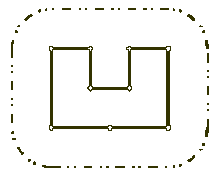Wall
| Time Limit: 1000MS | Memory Limit: 10000K | |
| Total Submissions: 43274 | Accepted: 14716 |
Description
Once upon a time there was a greedy King who ordered his chief Architect to build a wall around the King's castle. The King was so greedy, that he would not listen to his Architect's proposals to build a beautiful brick wall with a perfect shape and nice tall towers. Instead, he ordered to build the wall around the whole castle using the least amount of stone and labor, but demanded that the wall should not come closer to the castle than a certain distance. If the King finds that the Architect has used more resources to build the wall than it was absolutely necessary to satisfy those requirements, then the Architect will loose his head. Moreover, he demanded Architect to introduce at once a plan of the wall listing the exact amount of resources that are needed to build the wall.

Your task is to help poor Architect to save his head, by writing a program that will find the minimum possible length of the wall that he could build around the castle to satisfy King's requirements.
The task is somewhat simplified by the fact, that the King's castle has a polygonal shape and is situated on a flat ground. The Architect has already established a Cartesian coordinate system and has precisely measured the coordinates of all castle's vertices in feet.

Your task is to help poor Architect to save his head, by writing a program that will find the minimum possible length of the wall that he could build around the castle to satisfy King's requirements.
The task is somewhat simplified by the fact, that the King's castle has a polygonal shape and is situated on a flat ground. The Architect has already established a Cartesian coordinate system and has precisely measured the coordinates of all castle's vertices in feet.
Input
The first line of the input file contains two integer numbers N and L separated by a space. N (3 <= N <= 1000) is the number of vertices in the King's castle, and L (1 <= L <= 1000) is the minimal number of feet that King allows for the wall to come close to the castle.
Next N lines describe coordinates of castle's vertices in a clockwise order. Each line contains two integer numbers Xi and Yi separated by a space (-10000 <= Xi, Yi <= 10000) that represent the coordinates of ith vertex. All vertices are different and the sides of the castle do not intersect anywhere except for vertices.
Next N lines describe coordinates of castle's vertices in a clockwise order. Each line contains two integer numbers Xi and Yi separated by a space (-10000 <= Xi, Yi <= 10000) that represent the coordinates of ith vertex. All vertices are different and the sides of the castle do not intersect anywhere except for vertices.
Output
Write to the output file the single number that represents the minimal possible length of the wall in feet that could be built around the castle to satisfy King's requirements. You must present the integer number of feet to the King, because the floating numbers are not invented yet. However, you must round the result in such a way, that it is accurate to 8 inches (1 foot is equal to 12 inches), since the King will not tolerate larger error in the estimates.
Sample Input
9 100 200 400 300 400 300 300 400 300 400 400 500 400 500 200 350 200 200 200
Sample Output
1628
Hint
结果四舍五入就可以了
#include<iostream> #include<cmath> #include<algorithm> #include<cstdio> using namespace std; const int MAXN =1010; const double PI= acos(-1.0); //精度 double eps=1e-8; //避免出现-0.00情况,可以在最后加eps //精度比较 int sgn(double x) { if(fabs(x)<=eps)return 0; if(x<0)return -1; return 1; } //点的封装 struct Point { double x,y; Point (){} //赋值 Point (double _x,double _y) { x=_x; y=_y; } //点相减 Point operator -(const Point &b)const { return Point (x-b.x,y-b.y); } //点积 double operator *(const Point &b)const { return x*b.x+y*b.y; } //叉积 double operator ^(const Point &b)const { return x*b.y-y*b.x; } } ; //线的封装 struct Line { Point s,e; Line (){} Line (Point _s,Point _e) { s=_s; e=_e; } //平行和重合判断 相交输出交点 //直线相交和重合判断,不是线段, Point operator &(const Line &b)const{ Point res=b.s; if(sgn((e-s)^(b.e-b.s))==0) { if(sgn((e-s)^(e-b.e))==0) { //重合 return Point(0,0); } else { //平行 return Point(0,0); } } double t=((e-s)^(s-b.s))/((e-s)^(b.e-b.s)); res.x+=(b.e.x-b.s.x)*t; res.y+=(b.e.y-b.s.y)*t; return res; } }; //向量叉积 double xmult(Point p0,Point p1,Point p2) { return (p0-p1)^(p2-p1); } //线段和线段非严格相交,相交时true //此处是线段 bool seg_seg(Line l1,Line l2) { return sgn(xmult(l1.s,l2.s,l2.e)*xmult(l1.e,l2.s,l2.e))<=0&&sgn(xmult(l2.s,l1.s,l1.e)*xmult(l2.e,l1.s,l1.e))<=0; } //两点之间的距离 double dist(Point a,Point b) { return sqrt((a-b)*(a-b)); } //极角排序;对100个点进行极角排序 int pos;//极点下标 Point p[MAXN]; int Stack[MAXN],top; bool cmp(Point a,Point b) { double tmp=sgn((a-p[pos])^(b-p[pos]));//按照逆时针方向进行排序 if(tmp==0)return dist(a,p[pos])<dist(b,p[pos]); if(tmp<0)return false ; return true; } void Graham(int n) { Point p0; int k=0; p0=p[0]; for(int i=1;i<n;i++)//找到最左下边的点 { if(p0.y>p[i].y||(sgn(p0.y-p[i].y))==0&&p0.x>p[i].x) { p0=p[i]; k=i; } } swap(p[k],p[0]); sort(p+1,p+n,cmp); if(n==1) { top=2; Stack[0]=0; return ; } if(n==2) { top=2; Stack[0]=0; Stack[1]=1; return ; } Stack[0]=0;Stack[1]=1; top=2; for(int i=2;i<n;i++) { while(top>1&&sgn((p[Stack[top-1]]-p[Stack[top-2]])^(p[i]-p[Stack[top-2]]))<=0) top--; Stack[top++]=i; } } int main () { int n,l; cin>>n>>l; for(int i=0;i<n;i++) cin>>p[i].x>>p[i].y; Graham(n); double sum=0; for(int i=0;i<top-1;i++) sum+=dist(p[Stack[i]],p[Stack[i+1]]); sum+=dist(p[Stack[top-1]],p[Stack[0]]); sum+=PI*2*l; sum=(sum)*10/10; printf("%.f ",sum); return 0; }